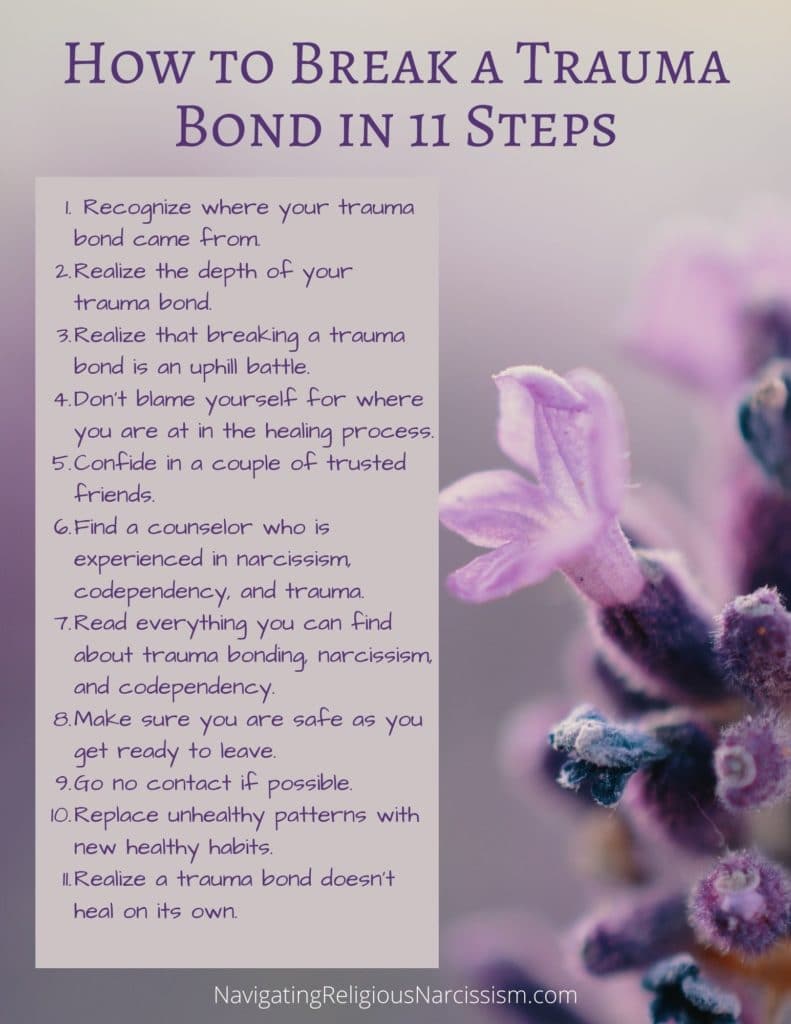Reviewed by Karis A. Williams, MSMHC, LPC, January 13, 2024
Toward the end of my 31-year marriage, my counselor never told me I was trauma bonded to my then husband. Her agency generally did not like to put names on conditions because they preferred to work with the behaviors and form new healthier patterns. What she did do was work weekly on ways for me to heal and break the trauma bond that she very carefully didn’t name. And week by week, the healing came steadily.
So, what are the steps to break a trauma bond? First, you must realize it is a process. Healing is not instant or quick. I listed ten of the most prominent steps here. Recognizing where your trauma bond came from, the nature of your trauma bond, and working with professionals and friends who understand trauma bonding is all critical to healing. Learning healthy habits to replace trauma bonding behaviors will get you on the right path sooner than you think. And with the necessary time and exercises in healing, you will be amazed at the positive changes in your life.
Let’s take a closer look at the ten steps in this article. But first, if you think you are in any danger in your relationship, contact the National Domestic Violence Hotline at 1-800-799-SAFE (7233). Or you can visit online at thehotline.org.
Table of Contents
Recognize Where Your Trauma Bond Came From
In order to understand how you got into a trauma bond with someone close to you, you need to recognize where your propensity to form unhealthy bonds comes from. Generally speaking, when children are raised in homes where one or both parents (or another close guardian) are abusive, they commonly develop codependency and/or trauma bonding issues.
As abused children grow up, they tend to end up on one of two different tracks. About one-third of them continue the cycle and become abusers themselves (see this article about that in The New York Times). The other two-thirds tend to be incredibly aware of the feelings around them, also known as empaths. It is this two-thirds of people that also grow up to be serial victims in their relationships because they don’t see the red flags of abuse. Instead they tend to see the humanness and charm of their abuser and feel like there are more benefits to staying than leaving.
When a child (or adult for that matter) has a close relationship with someone who is abusive to them, they see much more than the abuse. The see the humanness of the abuser. They hear their hopes and dreams. And they also usually know the background of the abuser, which often shows that the abuser started out as a victim of abuse. An abuser can, in fact, be very charming. In fact, they can be charming and nice more than they are abusive. And that is one big reason trauma bonding victims choose to stay.
If victims could recognize the depth of abuse and get to a healthy place, they would be able to gain the strength to leave the trauma bonding relationship. Often, this happens in the counseling office, but many victims don’t see themselves as victims needing the help of a counselor. But once they can see the source of their proclivity for trauma bonding, often healing can begin immediately and they will thrive in their new emotionally healthy life.
Do you think you may be involved in a trauma bond relationship? Take this test to get more information!
Realize the Depth of the Trauma
Trauma bonding is not just a pattern of behaviors that develop out of long term abuse. It actually forms a chemical reaction in the brain based on the production of oxytocin. According to Psychology Today, oxytocin has dual functions in women. It is first a reducer of stress or anxiety. But then it can actually go to the opposite route and induce stress and anxiety. As it turns out, oxytocin performs based on social cues. You can read more about that in this Psychology Today article.
There are three other chemical reactions caused by trauma bonding. They are:
- endogenous opioids, molecules which affect our pleasure and pain responses as well as determine withdrawal or even dependence on others,
- corticotropin-releasing factor, a major regulator of the hypothalamic pituitary adrenal (HPA) axis response which can trigger depression the perceived need to withdraw, and stress, and
- dopamine, a neurotransmitter that your body makes and nervous system uses to send messages between brain cells regarding cravings, seeking and wanting certain things.
When these factors are out of sorts, it is nearly impossible for the trauma bonding victim to see their situation realistically and act accordingly. That is what makes them staying a victim such a common occurrence.
Generally speaking, unless a trauma bonding victim gets help from someone on the outside who can see the “whole picture,” they will not be able to see for themselves well enough to know they need to get out of an unsafe situation. Recognizing the depth of the trauma will enable the victim to start seeing things in a more healthy light so they will be able to heal and move forward.
*Note: For the best resources on understanding, dealing with, and healing trauma bonds, click here!
Realize that Breaking Free From a Trauma Bond Will be a Very Uphill Battle
Once a victim realizes the depth of the trauma bond they are in, the ability to break a trauma bond increases dramatically. But even with that knowledge and the willingness to break free, the journey will be a long uphill battle. The victim will need to have several forms of support in place. Those include a close friend/confidante who can keep details confidential; a counselor experienced in trauma bonding, codependency, and narcissistic issues; good books to read that will help them to grow emotionally healthy and strong, and other supports you can read about in this article.
When I was emerging from my abusive marriage, the term trauma bond did not come up. My counselors were more into healing behaviors and a process of recognizing red flags and working through them than naming the issues. They believed that it led to a quicker and more wholesome healing because nobody was focusing on the maladies. Being on the other side of that life, I am glad they did it that way.
I had no idea that my struggle would be such an uphill battle. But I am really glad about that. I may have felt so defeated from the start that healing would have felt impossible. What I did notice over time was that the way I was handling abuse as it came at me was so much better. The way I felt about myself learning to react in healthy ways was amazing. I started to feel that I was finally in control of my life and how people could or could not treat me. And now, I live in an entirely different world. Plus, the icing on the cake, I am now able to help others gain the same healthy life out of their current ashes.

Where My Trauma Bond Healing Started
The single most helpful concept that got me started on healthy responses was Leslie Vernick’s CORE strength acronym. Here is what it stands for:
C – I will be committed to truth, both internally in my own heart and mind and externally. I refuse to pretend.
O – I will be open to the Holy Spirit and wise others, teaching me, maturing me, and guiding me into his way of living my life.
R – I will be responsible for my own responses to destructive behavior and commit to being respectful without dishonoring myself.
E – I will be empathic and compassionate toward others without enabling people to continue to abuse and disrespect me.
Ms. Vernick says that once we realize our value as human beings and learn to operate from that space, toxic people no longer have the power to manipulate us.
You can read about this in its entirety in The Emotionally Destructive Marriage. This is my number one recommended book for anyone in a destructive or even difficult marriage because it deals with identifying what kind of marriage you are in. Then it shows you how to navigate both kinds and make the best decision for your situation. I am pretty sure it will be as life-changing for you as it was for me!
Don’t Blame Yourself for Where You Are In the Healing Process of a Trauma Bond
For years, I would always think, “If only I had…,” or “What if I…,” or any number of similar phrases implying that I should have known better or done better. But that type of thinking does no good. It causes us to be trapped in a victim mentality. And it makes us think that we are somewhat to blame for the bad reactions or inability to see the situation for what it was and get out from under it.
It honestly doesn’t matter if we did the wrong things or didn’t get out sooner or whatever other things we could have done differently or better. The important thing is that we move in a healthier direction now.
Blaming yourself for the things that happened is internalizing all of the blame shifting that happened to you in the trauma bond. Your abusive partner told you that what they did to you was your fault. And now if you are blaming yourself for not doing better at the moment you are continuing that trend.
It is fine to recognize that you need to do better now that you know. And in order to heal, you have to recognize and change the behaviors that kept you trapped in the trauma bond. And with that change, you will see yourself breaking the trauma bond more and more with each healing exhange you have with your abuser.
Guess what? As this healing process continues, you will start to feel so much stronger and maybe even proud of yourself for the first time! And that will motivate you to keep on going!
Just know that there will be some rough days. You won’t respond the way you should. And that’s okay. The healing process is not all or nothing. It is a series of ups and downs. And when the ups become more frequent than the downs, you will know you are healing. And when the downs become rare, you will start to feel how emotionally healthy you have become. AND…you will start to see that expand out into your other relationships as well!
Confide in a Couple of Friends to Help Break a Trauma Bond
Having a couple of good friends to confide in to break a trauma bond is critical to your healing. But it is also potentially dangerous. What if your friend doesn’t keep your facts, feelings, and thoughts private? What if they go back to your abuser? Or what if they don’t understand? What if they blame you for what has happened?
Those who have been in trauma bonding relationships understand that it is really hard to trust even your closest circle of friends. That is because the person you were supposed to trust the most was the one that hurt you the most. It is hard to know where to turn to find a safe relationship.
To this I say you should tread lightly. Only approach people that you think you can trust. Entrust them with a little bit of information that won’t do harm if it gets around to the wrong ears. It won’t take long for you to know whether or not they are trustworthy with the information you are giving them as you ask for support.
The most important companion step to this one is the very next one, getting counseling from someone who is well versed in trauma, codependency, and narcissism. You will be able to bounce your conversations off your counselor and they can tell you if you are safe in the ways you are proceeding.

Get Counseling to Break a Trauma Bond
To continue with the thought I started in the last point, getting a counselor that understands your issues is critical. And you need to make sure it is someone you feel totally comfortable sharing your deepest feelings with. Being comfortable with how they react to you is one of the most important criteria for choosing your therapist.
I didn’t choose to go to a counselor on my own. Because my ex-husband had such a stellar public reputation, I didn’t think there was anyone who could help me. So I stayed in silence. He was the one who recommended couples counseling because I was no longer doting on his every wish and he wanted that back. He was going to drag me to counseling so I could be “obedient” to him once again.
Fortunately for me, the counselor he chose was one that saw what was going on almost immediately. I was shocked that when I said something in my crazy, mixed up words that couldn’t put a thought together, she knew exactly what I was saying. She could repeat it back to me in words that made sense and explained exactly how I felt. I was shocked.
After a few months, she asked for me to break out from the couples counseling we were doing so she could start working with me personally toward healing (and also get me to a safe counseling space where my husband could no longer “punish” me for saying things he didn’t want known). My ex also got his own counselor because he wasn’t working with her anymore but instead trying to control the sessions. His new counselor was chosen for him because they had a lot of life experiences in common. It was hoped that would be enough for him to be able to work with the new counselor. It didn’t work. My ex burned through 6 or 7 counselors before declaring he was just fine and they were all wrong and unbiblical.
I wish that everyone had the success I had with their first counselor. But if not, know that there is someone out there. Just keep looking until you find them!
Read Everything About Trauma Bonding, Codependency, and Narcissism You Can Find to Break a Trauma Bond
My counselor (yep, the one I was glowing about in the previous point) always had a great book recommendation for me. Most of them you can find here. These were the ones that were most instrumental for helping me to see what was really happening to me and learn to heal. Without them I think I could very well still be struggling. But the one that still means the most to me even now after I am far removed from the abuse is the one I mentioned above, The Emotionally Destructive Marriage.
While you can see many of the resources that were so helpful to me by clicking the link above, here I will give you the order in which I think they are most important, beginning with the first one:
- Emotionally Healthy Spirituality
- Why Does He Do That?
- Boundaries
- The Narcissism Recovery Journal
- The Gaslighting Recovery Workbook
- Narcissism in the Church
- When Narcissism Comes to Church
Reading these books in conjunction with the friends and counselor support will help you learn to think in healthier patterns almost immediately. You will be amazed at how much you feel like your life is yours!
It’s kinda funny that all those years I actually thought I was making emotionally healthy decisions and behaving in healthy ways. Counseling and these books showed me what I had been missing my whole life and how I needed to navigate my way through the mess. I hope they have the same result for you!
Make Sure You are Safe From Your Narcissist When You Break a Trauma Bond
Once you have learned that you are indeed likely in a trauma bonded relationship, deciding to break a trauma bond and leave the abuser is not so cut and dry. If you were not safe during the relationship, telling your abuser that you are leaving is generally even less safe. You must plan accordingly and have good avenues of support in order to safely break a trauma bond.
I was very blessed to have my church leadership walk through the process with me. I was never alone. This was especially important because toward the end of our time together, during in-house separation, he started physically posturing over me when he was angry. As the church was aware this was going on and was seeing angry behavior in our church meetings, they had already warned me of ways to stay safe if he went too far off the rails. The church leaders were also in regular contact with our counselors, who were also witnessing the same behavior from him.
Getting Support for my Separation
So when I told my church leaders I was ready to move forward with separation, they actually stepped in and started helped plan the process with me. We met with the church leaders on a Tuesday evening. I didn’t realize it at the time, but they actually announced to him that it was time for us to separate and that if I hadn’t requested it, they were going to insist on it anyway because our home had become so toxic. He went ballistic, confirming their decision to assist me rather than me trying to break the news to him alone. That would have been disastrous for me and possibly the kids.
The next meeting was that Friday morning with my ex and me, our church leadership, and our counselors. It was supposed to be a strategy meeting to figure out what our separation would look like. My ex wasn’t playing. He would bargain nothing and was willing to go to great lengths of destruction to keep control. He said I could leave but I could never have the kids (that he had had very little to do with for our entire 27-year marriage at that point).
Because of his belligerence, his counselor ended the meeting. He immediately stormed out, and that’s when things got real. The elders started talking about places I could stay and my pastor told me to call the kids and have them packed and at our church in an hour so we could meet them and figure things out. I rushed home to help them pack so we could all meet back up at church.
By the time we got there a home had been found for us to stay in until I could get the legal paperwork done for a separation that would allow the kids and me to be safely taken care of and back in our home. It took 10 days.
I don’t know what would have happened if I hadn’t had all of those supports in place.
Go No Contact (or Limited Contacted with Shared Kids) When Breaking a Trauma Bond
In order to break a trauma bond, you cannot keep going back to your abuser on a regular basis. It is confusing to the abuser because they think they could possibly be getting you back. Or that they could have a chance to get you back. Any contact with you is an opportunity in their eyes.
It is also confusing for you. Your senses will automatically put you back in the place you had been for so long. Your thought patterns will want to revert back to those times.
Because of those factors, you really need to go no contact with the person you were trauma bonded with. But in the case of shared children, it is rarely possible. Unfortunately, the courts do not consider emotional abuse dangerous enough to keep the kids away from the abuser. Even some physcial abuse was considered “not bad enough to keep the kids away from their father” according to one of the judges we had. It is mortifying to a mom who finally gets herself and her kids away from the abuse and the courts are not willing to help with keeping her and the kids safe.
I was lucky enough to have lawyers, counselors, a guardian ad litem, and a judge that all agreed our youngest son should not spend overnights with his dad and only a few hours a week in a public place. Most families are not so lucky.

Ways to Make Co-Parenting Safe
If you are in a position where you have to be in regular contact with the person you were trauma bonded with, there are avenues that can keep you safe. Here are a few:
- Make all drop off and pick up locations public or at least make sure someone else is with you if it is at your home or the ex’s.
- Don’t communicate verbally. All communication should be through text, email, or handwriting. Most courts allow texts now, but if yours doesn’t, there are apps that will work for submitting evidence for court. One good one is Our Family Wizard.
- Schedule parenting time with the other parent during times that other family members or friends will be there or activities that they can do together that will be in public. This will be tricky, especially if the other person feels they are not in control of everything. My pastor and counselors said the best way to do this was to make him think everything was his idea by planting a seed and letting him come up with the rest. Then he was happy and kids were safe.
At this point, the idea is keeping the kids safe until they come to the age of deciding what they want for themselves. It is also incredibly important to teach your kids ways to keep themselves emotionally healthy when you are not there with them. Counseling for them and sharing the things you learned yourself are great ways to do that with them.
Learn to Replace Your Trama Bonded Habits With Healthy Habits
I have to admit, this was one of my favorite parts of the healing process. I could actually see the ways I was growing emotionally. And the stronger, braver and more healthy I got, the faster healing progressed. It was like the snowball that starts at the top of the mountain and is so huge by the time it gets down to the bottom.
In order to break a trauma bond, you have to have plans in place, but you also have to learn healthier behaviors to avoid attracting more trauma bonding relationships in the future. These relationships can appear literally anywhere and everywhere. And they WILL find you. If the first one did, there are plenty more where that one came from.
The best way to keep yourself safe going forward is to change the behaviors that got you in trouble in the first place. Finding your CORE strength is a great beginning. Implementing one of those letters a week will help you grow strong in a conscientious way.
And once you become proficient with that, the next book you need to go through is Boundaries by Henry Cloud and John Townsend. It is best for you to read these before you try to go out on your own. Then you will have the strength you need to branch out. But if your spouse will get angry seeing those books, be careful to keep them at work, a friend’s house, or somewhere safe in your own house.
Can Trauma Bonds Break on Their Own?
Can a person just decide to walk away on their own to break a trauma bond? While it sounds like it could be possible to just decide one day that you’ve had enough, that is a very unlikely scenario.
The truth is that there are so many things holding you in that trauma bond that you will likely never break away on your own. Those chemical reactions we talked about at the beginning of this article may be the biggest obstacle. Your own body is fighting against you after living in the proverbial slow boil.
Additionally, you feel sympathy for your abuser. You feel that without you there is no hope of them healing (even though your chance of helping them heal is next to nothing at this point). Or some of you may feel that if you try to break away, your abuser will come after you. Fear is a huge deterrent to declaring your freedom.
Honestly, you could go through each one of the points in this article and see them as a deterrent for breaking free from your trauma bond. And each one of them can certainly hold you back. But most trauma bond victims have a combination of the above issues, keeping them even more trapped in their trauma bond. Without the very necessary supports in place, you will have very little chance of getting to safety on your own.
Studies have shown that the average time a victim leaves her abuser before finally breaking free forever is 4 times. And each time they go back, the abuse gets worse. (Read more about this here.) I was fortunate enough to break away the first time. I hope you will find the same success!
What was your experience? How were you able to get to safety? How long did it take? How many times did you have to leave before you finally broke free? I would love for you to share in the comments below. If you cannot post publicly, please feel free to contact me here.
Blessings to you!

If you liked this article, I think you will also love the following articles:
Are You Trauma Bonded? Take This Test to Find Out!
Recognizing & Dealing With Trauma Bonding Withdrawal Symptoms
Types of Trauma Bonding: What You Need to Know
The Seven Stages of Trauma Bonding: An In-depth Look
Signs of Trauma Bonding You Need to Look Out For
What to do When Your Narcissist Threatens You
The Bible Used as a Weapon Against You: You can Overcome!
What Does the Bible say About Abusive Husbands?
The Link Between Spiritual Abuse and Narcissism
What Does the Bible Say About Abusive Husbands?
The Link Between Spiritual Abuse and Narcissism
Can a Narcissist Change for Love?
Why are You Attracting Narcissists?
Why Narcissists Love Going to Church
Does a Narcissist Know They are a Narcissist?
How Religious Narcissists Think?
Can a Narcissist be a Good Person?
Narcissistic Behavior: What to Look Out For
Praying for Your Narcissistic Husband
Are Spiritual Narcissists Overt or Covert?
How to Navigate Religious Narcissistic Parents
What Happens to the Soul of a Narcissist?
How to Heal From a Spiritual Narcissist
Can You Maintain a Relationship With a Spiritual Narcissist?
Can Narcissists Have a Spiritual Awakening?
How Will God Judge a Narcissist?
When the Church Says to Move Back in With Your Narcissist
What Can We Say to a Friend Who’s Divorcing
23 Reasons Why Narcissists are Drawn to the Church
When the Church Doesn’t Recognize Narcissistic Abuse
Will the Church Support Divorcing a Narcissist?
What Does the Bible Say About Narcissism?
Can a Spiritual Narcissist Heal?
Can a Narcissist Be a Christian?
What Does the Spiritual Narcissist Do When You Try to Leave?
- How to Choose the Best Attorney When Divorcing a Narcissist - March 23, 2024
- Why Won’t God Heal my Narcissist? - February 28, 2024
- How Narcissists Use Religion to Control and Manipulate You - December 26, 2023






